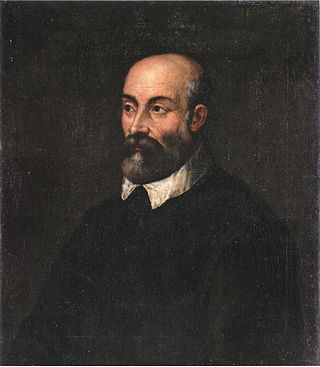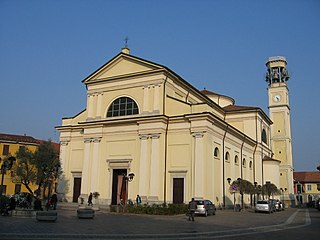
Livorno is a port city on the Ligurian Sea on the western coast of Tuscany, Italy. It is the capital of the Province of Livorno, having a population of 158,493 residents in December 2017. It is traditionally known in English as Leghorn.

Andrea Palladio was an Italian Renaissance architect active in the Venetian Republic. Palladio, influenced by Roman and Greek architecture, primarily Vitruvius, is widely considered to be one of the most influential individuals in the history of architecture. While he designed churches and palaces, he was best known for country houses and villas. His teachings, summarized in the architectural treatise, The Four Books of Architecture, gained him wide recognition.

The Basilica di Santa Maria Gloriosa dei Frari, commonly abbreviated to the Frari, is a church located in the Campo dei Frari at the heart of the San Polo district of Venice, Italy. It is the largest church in the city and it has the status of a minor basilica. The church is dedicated to the Assumption of Mary.

The basilica diSan Pietro is a Catholic basilica and abbey in the Italian city of Perugia. Its bell tower, standing at 70 meters tall, is the tallest structure in Perugia and is one of the city's most significant symbols. It is an Italian national monument

Diano Castello is a comune (municipality) in the Province of Imperia in the Italian region Liguria, located about 90 kilometres (56 mi) southwest of Genoa and about 5 kilometres (3 mi) northeast of Imperia. As of 31 December 2004, it had a population of 2,061 and an area of 6.0 square kilometres (2.3 sq mi).

Colletorto is a comune (municipality) of approximately 1,786 inhabitants in the Province of Campobasso in the Italian southern region of Molise, located about 45 kilometres (28 mi) from the capital of the region Campobasso and 40 kilometres (25 mi) from Termoli (CB) sea town with port, railway and highway A14.

Mantua Cathedral in Mantua, Lombardy, northern Italy, is a Roman Catholic cathedral dedicated to Saint Peter. It is the seat of the Bishop of Mantua.

Giovanni Antonio Fasolo (1530–1572) was a late Renaissance Italian painter of the Venetian school, active in Vicenza and surroundings.

Padua Cathedral, or Basilica Cathedral of Saint Mary of the Assumption, is a Catholic church and minor basilica located on the east end of Piazza Duomo, adjacent to the bishop's palace in Padua, Veneto, Italy.

The Duomo of Monza, often known in English as Monza Cathedral, is the main religious building of Monza, Italy. Unlike most duomi, it is not in fact a cathedral, as Monza has always been part of the Diocese of Milan, but is in the charge of an archpriest who has the right to certain episcopal vestments including the mitre and the ring. The church is also known as the Basilica of San Giovanni Battista from its dedication to John the Baptist.

San Marco is a church in Milan, northern Italy.

Villa Caldogno is a villa in the Veneto region of Italy, which is attributed to Italian Renaissance architect Andrea Palladio. It was built for the aristocratic Caldogno family on their estate in the village of Caldogno near Vicenza. It is also known as the "Villa Nordera" after Dr. Ettore Nordera who owned the property through a large part of the 20th century.

Santa Maria del Carmine is a church in Pavia, Lombardy, northern Italy, considered amongst the best examples of Lombard Gothic architecture. It was begun in 1374 by Gian Galeazzo Visconti, Duke of Milan, on a project attributed to Bernardo da Venezia. The construction followed a slow pace, and was restarted in 1432, being finished in 1461.

Palazzo Valmarana is a palace in Vicenza. It was built by Italian Renaissance architect Andrea Palladio in 1565 for the noblewoman Isabella Nogarola Valmarana. Since 1994 it is part of the UNESCO World Heritage Site "City of Vicenza and the Palladian Villas of the Veneto".

Montisi is an Italian village in the municipality of Montalcino, Province of Siena, Tuscany. It sits on a hill on the boundary between the Val d'Orcia and the Crete Senesi.

San Filippo Neri, also called the Chiesa dei Filippini or San Marcello in San Filippo Neri, is a Neoclassical-style, Roman Catholic church located on Corso Palladio #35 in the city of Vicenza, region of Veneto, Italy.

The church of San Francesco of Assisi is a Catholic religious building in Pavia, Lombardy, Italy.

The collegiate basilica of St. Barnabas is the main place of Catholic worship in the city of Marino, in the metropolitan city of Rome Capital and suburbicarian diocese of Albano.





























